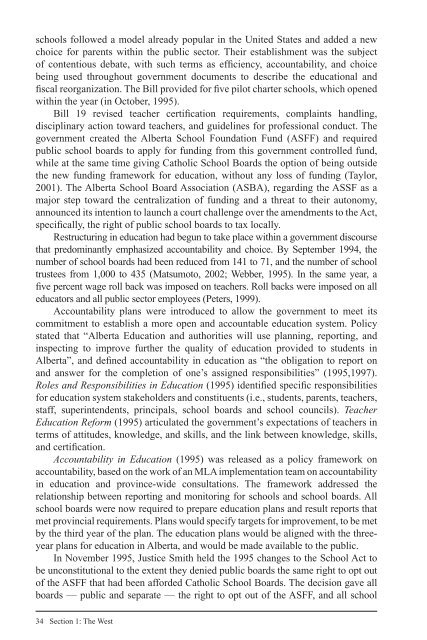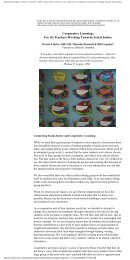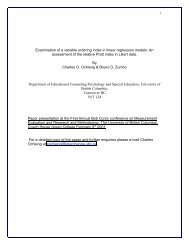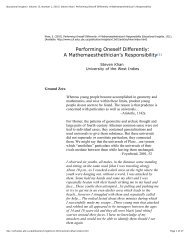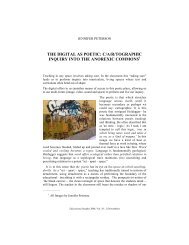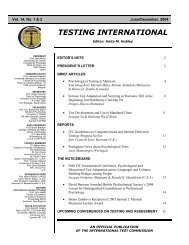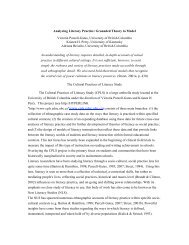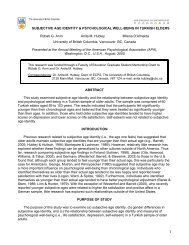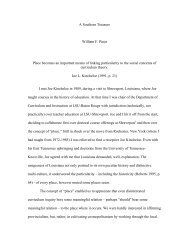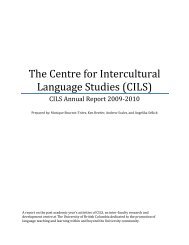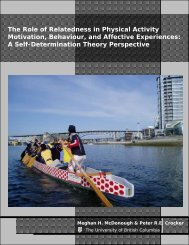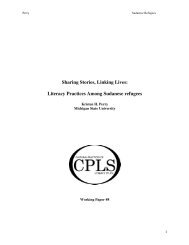The evolution of professionalism - Centre for Policy Studies in ...
The evolution of professionalism - Centre for Policy Studies in ...
The evolution of professionalism - Centre for Policy Studies in ...
You also want an ePaper? Increase the reach of your titles
YUMPU automatically turns print PDFs into web optimized ePapers that Google loves.
schools followed a model already popular <strong>in</strong> the United States and added a new<br />
choice <strong>for</strong> parents with<strong>in</strong> the public sector. <strong>The</strong>ir establishment was the subject<br />
<strong>of</strong> contentious debate, with such terms as effi ciency, accountability, and choice<br />
be<strong>in</strong>g used throughout government documents to describe the educational and<br />
fi scal reorganization. <strong>The</strong> Bill provided <strong>for</strong> fi ve pilot charter schools, which opened<br />
with<strong>in</strong> the year (<strong>in</strong> October, 1995).<br />
Bill 19 revised teacher certifi cation requirements, compla<strong>in</strong>ts handl<strong>in</strong>g,<br />
discipl<strong>in</strong>ary action toward teachers, and guidel<strong>in</strong>es <strong>for</strong> pr<strong>of</strong>essional conduct. <strong>The</strong><br />
government created the Alberta School Foundation Fund (ASFF) and required<br />
public school boards to apply <strong>for</strong> fund<strong>in</strong>g from this government controlled fund,<br />
while at the same time giv<strong>in</strong>g Catholic School Boards the option <strong>of</strong> be<strong>in</strong>g outside<br />
the new fund<strong>in</strong>g framework <strong>for</strong> education, without any loss <strong>of</strong> fund<strong>in</strong>g (Taylor,<br />
2001). <strong>The</strong> Alberta School Board Association (ASBA), regard<strong>in</strong>g the ASSF as a<br />
major step toward the centralization <strong>of</strong> fund<strong>in</strong>g and a threat to their autonomy,<br />
announced its <strong>in</strong>tention to launch a court challenge over the amendments to the Act,<br />
specifi cally, the right <strong>of</strong> public school boards to tax locally.<br />
Restructur<strong>in</strong>g <strong>in</strong> education had begun to take place with<strong>in</strong> a government discourse<br />
that predom<strong>in</strong>antly emphasized accountability and choice. By September 1994, the<br />
number <strong>of</strong> school boards had been reduced from 141 to 71, and the number <strong>of</strong> school<br />
trustees from 1,000 to 435 (Matsumoto, 2002; Webber, 1995). In the same year, a<br />
fi ve percent wage roll back was imposed on teachers. Roll backs were imposed on all<br />
educators and all public sector employees (Peters, 1999).<br />
Accountability plans were <strong>in</strong>troduced to allow the government to meet its<br />
commitment to establish a more open and accountable education system. <strong>Policy</strong><br />
stated that “Alberta Education and authorities will use plann<strong>in</strong>g, report<strong>in</strong>g, and<br />
<strong>in</strong>spect<strong>in</strong>g to improve further the quality <strong>of</strong> education provided to students <strong>in</strong><br />
Alberta”, and defi ned accountability <strong>in</strong> education as “the obligation to report on<br />
and answer <strong>for</strong> the completion <strong>of</strong> one’s assigned responsibilities” (1995,1997).<br />
Roles and Responsibilities <strong>in</strong> Education (1995) identifi ed specifi c responsibilities<br />
<strong>for</strong> education system stakeholders and constituents (i.e., students, parents, teachers,<br />
staff, super<strong>in</strong>tendents, pr<strong>in</strong>cipals, school boards and school councils). Teacher<br />
Education Re<strong>for</strong>m (1995) articulated the government’s expectations <strong>of</strong> teachers <strong>in</strong><br />
terms <strong>of</strong> attitudes, knowledge, and skills, and the l<strong>in</strong>k between knowledge, skills,<br />
and certifi cation.<br />
Accountability <strong>in</strong> Education (1995) was released as a policy framework on<br />
accountability, based on the work <strong>of</strong> an MLA implementation team on accountability<br />
<strong>in</strong> education and prov<strong>in</strong>ce-wide consultations. <strong>The</strong> framework addressed the<br />
relationship between report<strong>in</strong>g and monitor<strong>in</strong>g <strong>for</strong> schools and school boards. All<br />
school boards were now required to prepare education plans and result reports that<br />
met prov<strong>in</strong>cial requirements. Plans would specify targets <strong>for</strong> improvement, to be met<br />
by the third year <strong>of</strong> the plan. <strong>The</strong> education plans would be aligned with the threeyear<br />
plans <strong>for</strong> education <strong>in</strong> Alberta, and would be made available to the public.<br />
In November 1995, Justice Smith held the 1995 changes to the School Act to<br />
be unconstitutional to the extent they denied public boards the same right to opt out<br />
<strong>of</strong> the ASFF that had been af<strong>for</strong>ded Catholic School Boards. <strong>The</strong> decision gave all<br />
boards — public and separate — the right to opt out <strong>of</strong> the ASFF, and all school<br />
34 Section 1: <strong>The</strong> West


